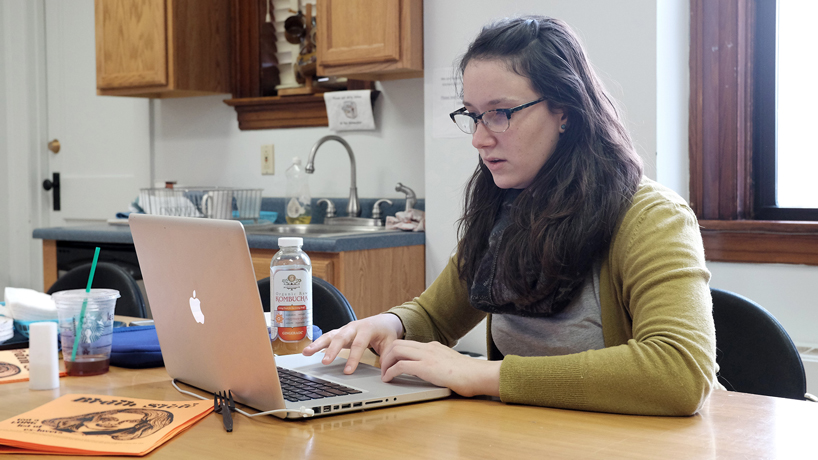
The behavioral workforce education training seminar, titled “A Discussion on Providing Affirming Care for Transgender and Nonbinary Clients in Behavioral Health Settings,” was led by Sarah E. Bruno and Vincent Mazzoccoli, two UMSL MSW graduates. (Photo by August Jennewein)
More than 70 social work and health care professionals tuned into a virtual seminar hosted by the University of Missouri–St. Louis School of Social Work Wednesday afternoon to learn about providing more informed care to transgender and nonbinary clients.
The behavioral workforce education training seminar, titled “A Discussion on Providing Affirming Care for Transgender and Nonbinary Clients in Behavioral Health Settings,” was led by Sarah E. Bruno and Vincent Mazzoccoli, two UMSL MSW graduates.
Bruno is a behavioral health clinician with experience in inpatient and outpatient settings and formerly worked for the Native American Rehabilitation Association of the Northwest. Mazzocoli, who is transgender, is a support manager at St. Louis Arc. Bruno has dedicated much of her professional career to providing affirming care, while Mazzocoli has consistently advocated for all people to feel safe in the workplace.
Over the course of two hours, the pair touched on a number of topics including: the history of transgender activists such as Marsha P. Johnson and Silvia Rivera, relevant terminology and definitions, national and local policies affecting transgender and nonbinary individuals and professional competencies and responsibilities necessary to provide affirming care in behavioral health settings.
Bruno noted that the presentation was a mix of peer-reviewed research, guidance from the World Professional Association for Transgender Health and lived experiences.
After a short history lesson, Bruno and Mazzocoli reviewed several general terms, which provide important context for treating transgender and nonbinary clients.
“They want to be treated as the person that they are,” Mazzocoli said. “So, meeting people where they are, it’s one of our core tenants of social work, and just allowing that client, that patient to be their authentic selves in order for them to receive the best care that we can provide.”
He began by discussing the difference between sex and gender. The former is the binary assignment of male or female by a doctor based on a newborn’s physical characteristics, while the latter refers to societal expectations based on a person’s sex.
“Gender expression is our outward expression towards society,” Mazzocoli added. “So, how I dress, how I grow my facial hair or whatever it may be.”
From there, Mazzocoli explained there are three big terms to understand and differentiate: transgender, cisgender and transsexual.
Broadly, transgender is an umbrella term for people whose gender identity does not match the sex they were assigned at birth. Conversely, cisgender refers to people whose gender identity generally matches the sex they were assigned at birth.
Transsexual was historically used to describe someone who had undergone medical procedures to affirm their gender identity. Though Mazzocoli said it’s come to be generally offensive and cautioned that the term should never be used unless someone explicitly identifies using it.
Bruno and Mazzocoli closed the lesson on terminology by stressing that nonbinary is not a third gender and also suggested using the term “gender expansive” to be inclusive.
“When I’m talking about people, I prefer to use ‘gender expansive’ because I feel like that includes everybody who’s not cis,” Mazzocoli said.
After a brief update on a local and national policies affecting transgender and nonbinary people, Bruno shifted to a discussion about the barriers, stigma and stress transgender and nonbinary people have historically faced in seeking behavioral health services and how professionals can acknowledge that and work to alleviate those difficulties.
She pointed out that in order to provide affirming care, behavioral health care providers must be aware of their own cultural identities and recognize their own cultural values, biases and privilege, as well as the power imbalance between provider and patient.
“The best thing I think we can do is be transparent, be very open about that,” Bruno said. “Be transparent about the process with the clients, helping them navigate all the systems involved, acknowledging that we are part of these institutions that have historically harmed trans clients.”
Mazzocoli added that care needs to be proactive and explicit to make sure clients and patients feel safe. To do so, Bruno recommended training in WPATH’s Core Competencies for Care Givers, which provides guidance on the caregiver and care receiver relationship, interdisciplinary practice, content knowledge and professional responsibilities.
Finally, they noted one of the simplest ways to provide a welcoming atmosphere is to use gender neutral language and greetings like, “Hey ya’ll” or “Hello folks,” and to be mindful of everyone’s pronouns.
“Pronouns are not preferred,” Mazzocoli said. “We don’t have preferred pronouns, everyone has pronouns. They just are.”














